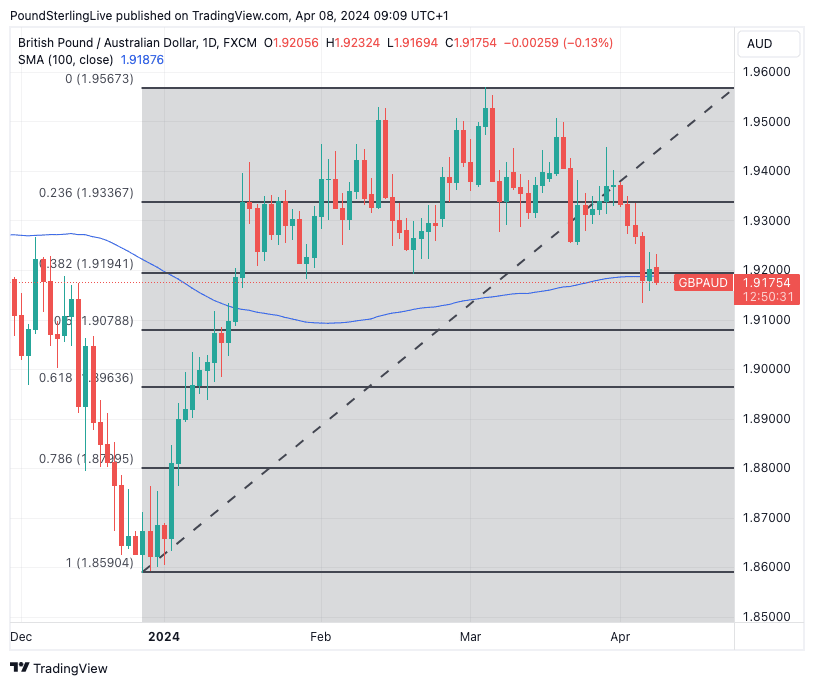GBP/AUD Week Ahead Forecast: Fresh Multi-week Lows Loom
- Written by: Gary Howes

Image © Adobe Stock
The Pound to Australian Dollar exchange rate is at risk of testing fresh multi-week lows in the coming days, especially if Wednesday's U.S. inflation report undershoots expectations.
GBP/AUD hit a 2024 peak at 1.9570 in early March and has been in retreat since last week, falling to the lower end of a January-March range, which is approximately 1.9170.
The question for those watching Sterling-Aussie is whether this line holds and results in a rebound, or it's just a short pit-stop on the way to December 2023 lows.
The chart below shows technical support in the form of the rising 100-day moving average, which coalesces with the 38.2% Fibonacci retracement of the GBP/AUD's January rally.
Above: GBP/AUD at daily intervals. Track GBP/AUD with your own custom rate alerts. Set Up Here
Short-term price action will be determined by whether Sterling can defend the level around 1.9170. Failure will lead to a quick restest of the next support area, around 1.9100.
For now, we expect support to give way as momentum currently favours the Australian Dollar.
This puts the Pound at risk of losing its status as one of 2024's best-performing currencies, thanks to fading interest rate yield support.
Compare GBP to AUD Exchange Rates
Find out how much you could save on your pound to Australian dollar transfer
Potential saving vs high street banks:
A$48.75
Free • No obligation • Takes 2 minutes
Pound Sterling had benefited from expectations that the Bank of England would be amongst the last central banks to cut interest rates, but it signalled in March it would soon be appropriate to cut rates.
This has seen markets raise expectations for a June rate cut, meaning the Bank would cut rates a good few months ahead of the Reserve Bank of Australia (RBA).
Indeed, the RBA could well be the last of the G10 banks to cut rates, which can offer AUD support against the currencies belonging to those central banks that are more proactive on the matter.
One key area of risk for the Aussie Dollar would be a broader deterioration in global risk sentiment resulting from the Federal Reserve forgoing a rate cut.
With U.S. data beating expectations, markets have already lowered the expected quantum of Fed rate cuts to approximately 68 basis points for 2024. Recall, at the start of the year it stood at 150.
This week's U.S. inflation report is important in this regard: should inflation beat expectations, we could see risk sentiment take a hit, and the AUD would be one of the bigger FX losers.
However, an undershoot in the inflation figure could result in an asymmetric market reaction that involves a leap in AUD, pushing GBP/AUD well below the current consolidation level.
If this is the case, GBP/AUD's 2024 gains could be threatened in the coming weeks.
The market looks for the headline CPI inflation rate to have risen to 3.4% year-on-year in March from 3.2% in February as it continues to drift further away from the Federal Reserve's 2.0% target.
The AUD can weaken should the figure exceed this, but given the reaction to last Friday's U.S. job report, we suspect an exceptionally strong reading would be required to deliver a significant depreciation. (Despite bumper employment growth, the USD was unable to benefit and AUD recovered initial losses).
Instead, the biggest market movement would likely follow and undershoot in the data, confirming an asymmetric FX reaction function heading into the print.
"A higher-than-expected print may add modest support to the USD but a downside surprise may see USD react more to the downside. Asymmetric DXY price action to US data is likely in the interim," says Christopher Wong, FX Strategist at OCBC.





